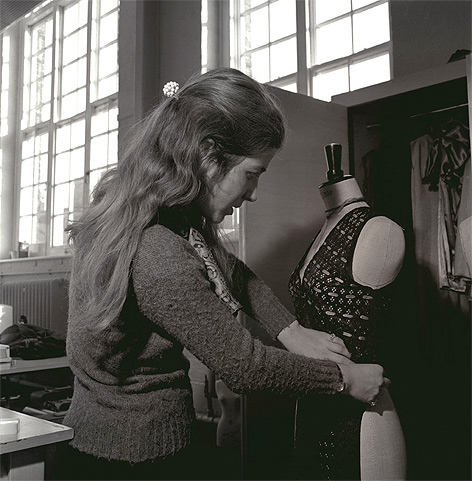
My first contact with the Fashion Department of Brighton College of Art was around 1967. We moved to Brighton in 1966 when my husband Joe got his job as a mathematics lecturer at the University of Sussex. My parents had a flat in Lewes Crescent and it was a town I had known well since my childhood. I had worked initially as milliner in Edinburgh and then, on a huge learning curve, as a junior curator with the impressive dress collection at the Royal Scottish Museum (now the Royal National Museum of Scotland). I was jobless when we moved to Brighton and I was 24 when I had first my first son, Reuben; my second son, Noah, was born in 1970.
I had taken a fashion design degree at St. Martin’s School of Art. Knowing my museum background, Muriel Pemberton, Head of Fashion at St Martin’s, invited me to teach fashion history for four days a term. I soon realized that she was fighting an ideological battle with the Art History Department to be allowed to employ a dress historian at all. All students were required to take a generalised art history programme and none were taught any specialist histories, except for the fashion students. I worked there at first very nervously and then with huge enjoyment till she retired in the late 1970s and I am happy to say that I taught John Galliano, Stephen Jones and Jo Casely Heyford their fashion history. I was, however, out of a job as soon as Muriel retired.
On my behalf Muriel wrote to Mary Bryan, Head of Fashion at Brighton College of Art, suggesting she might employ me. In the early 1970s, after one refusal and yet another insistent letter from Muriel, I was finally employed (I believe rather reluctantly) as a very part-time fashion history teacher. I taught one session a week on Dip AD courses. By the mid 1970s I was also the part-time, very poorly paid curator of costume at the Brighton Museum, juggling motherhood and work on the whole not too well. I worked on the fashion sections of a series of well-remembered exhibitions curated by John Morley, Art Deco, Death, Heaven and the Victorians, Gothick, Follies and Fantasies. My first book, Mourning Dress: A Costume and Social History (1983) came out of my Brighton Museum work, though I was still divided in my mind as to whether I wanted to be a curator or lecturer. By the late 1970s we were planning the first fashion gallery in the museum and collecting clothes at a quite furious rate. This, with a display based around themes from my teaching, opened in 1980 and won a Museum of the Year award.
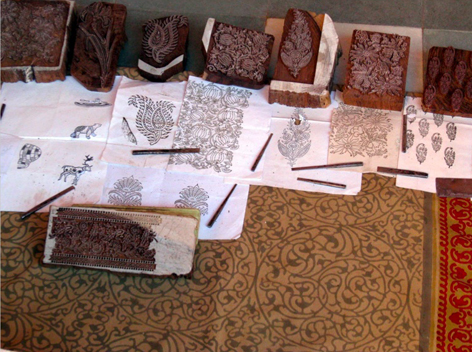 Image: Traditional Indian block printing. Photograph with kind permission of Hilary Miller, Industrial Liaison Coordinator, Faculty of Arts & Architecture, University of Brighton.
Image: Traditional Indian block printing. Photograph with kind permission of Hilary Miller, Industrial Liaison Coordinator, Faculty of Arts & Architecture, University of Brighton.Based in a crumbling primary school in Finsbury Road, some distance from Grand Parade, the Fashion Department seemed to live in a world of its own in the late 1960s. Coming out of a St Martin’s fashion training, I am ashamed now to say that I had no understanding of the Ditchling Arts and Crafts textiles ethos that was still in place. To my astonishment, spinning wheels and carding brushes lay about the ground floor and fashion ideas were firmly middle aged, mid-1950s, provincial and quite out of touch with any notion of ‘youthquake’ style. However, I very much enjoyed my teaching and slowly dug my way into the department, teaching my subject to myself as well as to my students as I went along. I was always interested in the dress of all countries and all classes but, back then, there were few texts on dress from Africa, India, China and other such countries, let alone the clothes of the poor in Britain or regional dress in Europe: there were only books on court dress and couture. With my fashion training I have always taught through analysis of surviving clothes, placing them in their social and cultural setting. It was not so easy to teach that way in the late sixties. Thank God that has situation has now utterly changed.
Within the Fashion Department of the university, the explosion of innovation and professionalism came in the mid-1970s when Michael McInerny took over the course. He was a weaver with strong industrial and creative experience, and with a passion for teaching. It was he who steered the exciting new BA Hons Fashion Textiles degree through its validation process as the art college became a polytechnic. By that time, and with Michael’s support, I had pushed my way on to the degree planning committees. This was partly because by then I was a member of the CNAA[1] validation committees for fashion/textile design and art history, another happy and instructive experience. Muriel Pemberton[2] put my name forward and I realize now that she did so knowing that I would fight to try get fashion history, rather than only art history, included in the curricula of the new programmes we were validating. Which indeed I did. It is hard, looking back, to remember just how deep-rooted the prejudices were against this kind of specialised teaching.
There were two great strengths to Brighton’s new BA Hons programme. The first, which drove the entire contemporary, invigorating ethos of the 4 year programme, was its placement year. Students go out into the real world of fashion and textile design for around 9 months to work in studios, workshops and factories all over the fashion world. They have to be prepared to be employable. They return as quite different people, even in their appearance and certainly in their understanding of the realities of the fashion/textile industries. Now we send students to China, India, and Australia, as well as to top fashion and textile design studios, fashion awareness companies, and other such places in London, Edinburgh, Paris, New York, Milan, Lyon, and Tokyo. Not surprisingly, this course has one of the best employment records of any in the university.
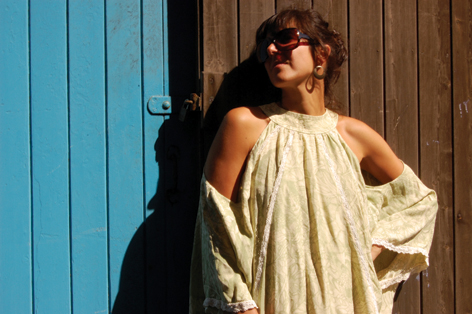 Image: Kaftan, thought to have been made by a Brighton Polytechnic fashion textiles student c. 1973. Modelled by University of Brighton student Tess Zahn, 2008. With thanks to Lou Taylor for the loan of the kaftan, and to Barbara Taylor for the photography.
Image: Kaftan, thought to have been made by a Brighton Polytechnic fashion textiles student c. 1973. Modelled by University of Brighton student Tess Zahn, 2008. With thanks to Lou Taylor for the loan of the kaftan, and to Barbara Taylor for the photography.Around 1980 John Miles took over, before he went on to the RCA, and he drove the department with a creative passion that was difficult to keep up with, raising the creative standard of work to higher and higher levels.
The second key innovative element of the new BA Honours degree was the (free) two week coach trip around Europe for the second year students, set in place by Michael McInerney. This was just as significant in learning terms for the two accompanying members of staff as it was for the undergraduates: these tours changed our outlook and aspirations, staff and students alike. Over the years our trips included trade shows in Düsseldorf and Paris. With a full coach-load of students, we also visited design studios, factories, boutiques and stores in Milan, Como, Paris and Lyon, where students found placements by showing their portfolios on the spot. We met textiles and costume curators at the Musée de l’Impression sur Etoffe in Mulhouse, the Musée des Tissus in Lyon, and at the Palais Galliera collection in Paris. On each trip staff made more contacts for placements and I made professional contacts in the museum world which had fundamental benefits for my own research and teaching right up to the present day. One year, when Laker flights to New York cost only £100 return, James Parke (Head of Weave) and I took 25 students there, a first visit for us all. We stayed in the wrong location, backing on to West 42nd Street. At night the security men upturned and chained a huge table to block any easy public access to the stairs: a bit scary! A bus and train transport strike was on and traffic slammed around the city all night long. However, through the invitation of Cipele Pineles Burtin, Head of Graphics at Parsons School of Art and my mother’s old friend from the 1930s, James and I attended a vastly grand dinner and fashion show at the New York Hilton, in the midst of a fearful storm. We learnt for ourselves to recognize the elegant conformity of New York fashion style. We also spent hours ringing studios, making the course’s first professional contacts in the industry and in the Metropolitan Museum, where I met the Fashion Curator, the excellent pioneering dress historian, Stella Blum.
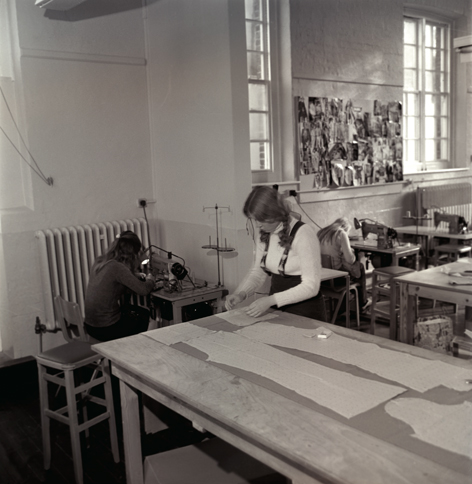 Image: Pattern cutting at Finsbury Road. Brighton School of Art Archive, The Design Archives.
Image: Pattern cutting at Finsbury Road. Brighton School of Art Archive, The Design Archives.On our first trip to Lyon we visited the Textile Museum and its director, Jean-Michel Tuscherer, together with famous silk fabricants’ houses, such as Bianchini-Ferier and Jacques Brochier. Jean-Michel was deeply shocked to find out that our hotel (the cheapest we could find) was in the red light district. That visit resulted eventually in me fundraising for, and curating, the Mariano Fortuny exhibition, which came from Lyon to Brighton Museum in 1980. When we could not get a hotel in Dussledorf to attend the InterstoffTextile fair, we had to stay in Darmstadt. Arriving at night, I woke up to find myself right in front of the Katerina Hoff and the wonderful Jugendstil art college building. Unable to find a cheap hotel in Milan one year, the travel agency booked us into a charming hotel in Bellagio, right on Lake Como, with blossoming wisteria climbing all over it. The waiters sang love songs under the windows of the students all night long.
There were, of course, other adventures. Coming out of Italy, driving through the Alps at night, the Austrian customs hauled an Azerbaijani student, Bahman Mostaghimi (later a highly innovative Head of Weave for 15 years) off the coach, insisting that his transit visa was flawed and that he must remain behind. He removed his suitcase from the hold of the coach for inspection. It turned out to be a very small brown leather one, almost entirely full of little balls of rainbow-coloured Italian weaving threads which burst out of the suitcase like a hundred demented little jack-in-the-boxes; much to the bafflement of the grim customs officials.
The world of fashion is a truly global trade. This is something all staff have long understood and, of all courses in the UK, ours best prepared graduates for its actualities: through the placement scheme, these international visits, the business studies course units and, I hope, my lectures, where I teach the histories of dress and manufacture from around the world.
The other half of my working life involves teaching and researching dress history and fashion studies in the context of design history and material culture. Design history as an academic field in the UK was largely developed here at Brighton by Penny Sparke[3] and Jonathan Woodham, evolving from their service teaching to our three-dimensional craft students. By 1980, Penny Sparke had set up the Design History BA programmes and opened up a small, small doorway for more dress history teaching. Again, throughout the 1980s, they too had to fight to get their subject accepted against the weight of prejudice from their art history colleagues, a fact that our design history and visual culture students would find hard to imagine today.
In the mid 1980s, a plan was mooted (not by me) that I would move from the Fashion Department into the Art History Department; a senior member of that department wrote a formal letter stating that neither I nor my subject was fit to join him. I guess it was a result of that kind of deep-rooted hostility that led me to campaign even harder in my field, leading finally to the publication of my two books. In The Study of Dress History (2002) and Establishing Dress History (2005). I enjoyed charting the erosion of the gender and subject-based prejudices again fashion and fashion history within the academic and museum worlds. I am convinced that these old battles have largely been won. By the 1990s, dress history had found a firm place in these teaching programmes, as it has in our MA History of Design and Material Culture and PhD research programme.
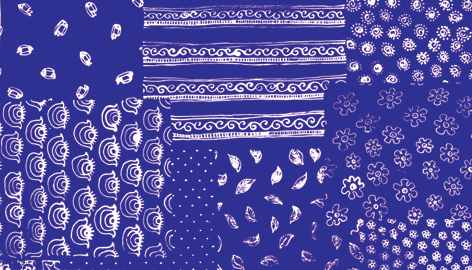 Image: Michele Payne, Temous scheme indigo blue print fashion project, c. 1992. Brighton School of Art Archive, the Design Archives.
Image: Michele Payne, Temous scheme indigo blue print fashion project, c. 1992. Brighton School of Art Archive, the Design Archives.We also took the design history students on coach study trips to visit key architectural sites and museums in Paris, Barcelona, Glasgow and Amsterdam. My involvement at first was to organise trips to Warsaw and Krakow from the late 1970s. Here we looked at pre-war architecture, at peasant culture and saw the reality of food and every other kind of shortage and petty restrictive bureaucracy under Soviet state socialism. These were for me life-changing trips. Jozef Mrozek, as an architectural guide around Warsaw and Krakow, taught me about the imposition of Stalinist architecture on Warsaw in the post-war perod; Barbara Hoff, Poland’s leading and only independent fashion designer, explained the surrealist complexities of the socialist industrial system; and Andras Ferkai guided us around the Modernist building in Budapest. In France, I stood in the Villa Savoye with Suzette Worden[4]. At the moment of the Chernobyl disaster, we even managed to take 25 design history students from Krakow to a peasant market in Nowy Targ in the foothills of the Tara mountains. The market was a mix of second hand clothes and huge bright blue vases featuring the Pope in cut glass, with mounds of seeds and adorable sheep dog puppies for sale. Many of the customers were wearing peasant hats and head scarves. I made a nice young design history student carry a huge brown clay pot all the way back to Brighton for me. Brighton’s Medical Officer of Health made everyone get thyroid tested when we got back to Brighton.
In Budapest we went to a major peasant dance festival, held annually. The students joined in more successfully in the round dancing than me; I could not catch the complexity of the rhythms. We bought peasant blouses, coats, glass paintings, baskets. Our coach, which was a real old banger anyway, ended up looking like a hippy traveller’s van. We had a fearsome time getting into France as the gun-toting customs men were convinced we were all carrying hash, if not worse. I still teach with the textiles I bought on that visit.
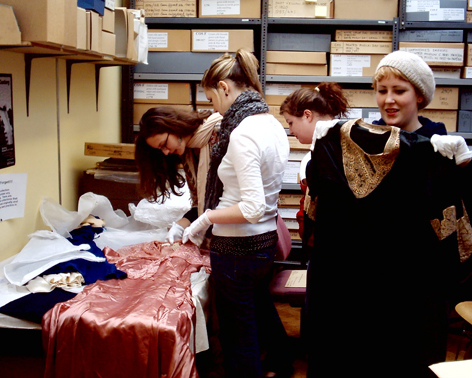 Image: Second year Design History students visit Wothing Museum and Art Gallery, 2006, Cheryl Roberts. With thanks to Worthing Museum and Art Gallery and Lou Taylor.
Image: Second year Design History students visit Wothing Museum and Art Gallery, 2006, Cheryl Roberts. With thanks to Worthing Museum and Art Gallery and Lou Taylor.What I determined in the 1980s, with the support of Bruce Brown, was to dent the stultifying mindlessness of the Cold War European divide by putting staff and students together, at least in the areas of design history and fashion, despite the enormous obstacles. All of this stemmed from an initial contact I made at a meeting in 1977 with the Rektor and staff of Warsaw Academy of Fine Art. They were elderly, very formal; both infinitely polite and infinitely sorry that such an idea was impossible. They had no funds and it had never been done before. Just as I gave up hope Jozef Mrozek, an art and design history lecturer who I had never met before and who was the youngest person in the room, asked simply ‘how do we know we can’t do this if we don’t even try?’ Contact was always made as difficult as possible by the East European authorities, but we persisted. By the mid 1980s we were exchanging groups of 25 –30 students. They travelled by coach or air, funded by George Soros and the British Council, and soon the trips were extended to fine art students. Thus over the years a great many staff explored Poland and later Hungary. We must have swapped a total of about 400 students, including some from Bucharest, at a time when as a rule neither staff nor students could get ‘out’, and we could not get ‘in’.
In 1989, just before the Berlin wall was torn down, we won a £240,000 bid from the EU Tempus office for staff-student exchanges in design and design history between Brighton, Warsaw, Budapest and Paris. This was achieved with the help of additional contacts developed in Budapest, through a British Council fashion exhibition that I had curated. This exchange programme ran for three years, just as everything changed politically in Europe. It was much aided by the energetic support of Bruce Brown, by our organisers in Budapest, Marti Kisfaludy, a fashion lecturer and Peter Viragvolgi, head of graphics, and in Warsaw Academy of Fine Art by Josef Mrozek and Wojciech Wybieralski, Head of the Department of Industrial Design. The joy was seeing the students together; I always felt that the strength in all of this work was in defying the political barriers placed between us and I am sure that in our small way we succeeded, just as Soviet state communism was collapsing around us. We were clearly instrumental in opening up design history research between Britain, Poland and Hungary. This work flowed out from opportunities generously supported and enabled by the open-mindedness of my faculty colleagues, and Bruce Brown in particular. In 1994 three Budapest students undertook George Hardie’s MA by Independent Study, at a very generously-reduced fee rate. Links still continue through a Socratesfunded staff exchange programme.
 LEFT: Chinese jacket. By kind permission of Nicholas Sinclair, and with thanks to Brighton Museum. Photographed by Mary Alison. RIGHT: Kaftan, thought to have been made by Brighton Polytechnic fashion textiles student c. 1973. Modelled by University of Brighton student Tess Zahn, 2008. With thanks to Lou Taylor for the loan of the kaftan, and to Barbara Taylor for the photography.
LEFT: Chinese jacket. By kind permission of Nicholas Sinclair, and with thanks to Brighton Museum. Photographed by Mary Alison. RIGHT: Kaftan, thought to have been made by Brighton Polytechnic fashion textiles student c. 1973. Modelled by University of Brighton student Tess Zahn, 2008. With thanks to Lou Taylor for the loan of the kaftan, and to Barbara Taylor for the photography. Lasting consequences did develop: there was one marriage, for example, between a Polish student and a British graphic design student. They live in London and their first baby was named ‘Liberty.’ Another consequence was that Poland caught the fascination of David Crowley, then a second year design history student, now a key design history lecturer at the Royal College of Art (RCA and co-curator of the Victoria and Albert Museum’s (V&A’s) major 2008 exhibition Cold War Design.
The £240,000 from the EU’s Tempus project allowed us to set about much smaller staff and student exchanges of longer duration between Warsaw Academy of Fine Art, the Academy of Craft and Design, Budapest and the École Nationale Superierue des Arts Décoratifs in Paris. That ran for over 4 years, just as the Berlin wall came down and the Soviet Union lost its grip on Poland and Hungary. I was invited to Warsaw in 2007 to give a lecture marking the 25th anniversary of the start of our exchanges. Nearly all the staff had been on our student exchange visits and told me of the lasting sense of hope and optimism that those visits had given them. As for me, many of my contacts in Paris, Lyon, New York, Warsaw, Krakow, Copenhagen, Stockholm and Budapest were formed at these moments or through attending conferences. For me this has been a vital aspect of the great pleasure that I still get from my teaching: unexpected, challenging and thrilling.
In 1972, I had spent three months in Ile-Ife in Western Nigeria, where my husband taught Mathematics for a year at the university. I spent my time looking after my kids and exploring local indigo blue adire fabric and the local markets. In 1981 Peter Lees, Julian Freeman (who then ran the Brighton Polytechnic gallery) and I put on an exhibition of Nigerian printed textiles. This included both adire and export print textiles. John Miles and Peter Lees hung all the lengths of fabrics beautifully. I found out years later that this was the first time export print (that is, fabric made in England and the Netherlands for sale in Africa) had ever been publicly displayed in Britain. John Picton told me that this was one of the triggers for his wonderful The Art of African Textiles exhibition and book, based at the Hayward Gallery in 1994.
Thanks to the blossoming of dress history and material culture approaches and a whole raft of innovative publications, I am now able to teach about Africa fashion and textiles, about East European design culture, about sub cultural style, about the great textile designers such as Sonia Delaunay, and about the Russian Constructivists. When I started my teaching career none of these texts existed. Now my fashion/textile students are fascinated to see these fabrics and research Africa Fashion Weeks, textiles of the Vienna Werkstätte or the work of conceptual fashion designers.
 Image: Lady Desborough dress, 1933. With thanks to Brighton Museum. Photographed by Mary Alison.
Image: Lady Desborough dress, 1933. With thanks to Brighton Museum. Photographed by Mary Alison. I remained a part-time teacher until the late 1980s, working also as the part-time costume curator at Brighton Museum. After a long struggle, I eventually became a full-time lecturer. I never found landing my university posts or promotion easy. There was still an astonishing amount of prejudice from the (male) art historians who dominated what was called the art history department. Fashion past and present was all too evidently considered a frivolous, unworthy subject, a prejudice I struggled against for years and years. As a teacher and researcher, I have always had one foot on the fashion/textile design world and the other in dress history and museum curating; an unsteady and problematic position to be in. I eventually recognized, however, that I really loved teaching more than curating as a full time activity. I have always enjoyed the challenge students offer, even if only to keep them awake in a hot lecture room. They have no idea of the fun and challenge of teaching them, aware as I am constantly that amongst them there may be another John Galliano, Emma Cooke, Mark Eley or David Crowley.
The museum world, too, has changed dramatically. I still work as much as I possibly can from ‘things’, either taking students to museum collections or using my own collection built up from street market buys and useful rejects from Worthing Museum. I concentrate hard on taking teaching into the museum world. David Crowley and I curated a show The Lost Arts of Europe in 2002 in the university gallery, based on a largely unknown but strong collection of European peasant artefacts (from the 1890-1935 period) at Haslemere Museum. In 2005, I worked with Amy de la Haye and Eleanor Thompson on a book and exhibition entitled Fancy and Fancy Dress, the Messel Dress Collection 1874-2004, based on Lady Anne Rosse’s family archives from Nymans and Birr Castle in Ireland. Both my collaborators had a long time before been my students on the design history course. We had more fun doing this than can be imagined. We involved a good few undergraduates and MA students too; again such a pleasure to set in place.
Now, we have developed a fashion history BA and have consolidated our MA in the History of Design and Material Culture. Dress and textile history has become so firmly established at the university, only I remember from time to time the long buried subject hostilities. Looking back, I can see that all my university or British Council-sponsored international travels dramatically altered and improved my teaching, research and publishing. My first PhD student Lesley Miller, who graduated in 1986, undertook research on the work of the Lyon silk designers in the 18th century. I had fallen under the spell of these fabrics and their history at the Musée des Tissus in Lyon on one of our early 1980s student coach trips. Lesley is now head of textiles at the V&A.
It certainly is important for lecturers to be researching and publishing, not only because it invigorates and updates teaching and the reputation of the Faculty, but because this throws us into the challenging world outside the safe walls of the university into settings where our work must stand up to international criticism. What is clear to me, after all these years of teaching, is that my dress history interests from student days are even now with me, still fresh and driving my research. I continue to write about dress from a little Upper Silesian village I stayed in as far back as 1961, when I studied there for my dissertation at St. Martin’s. What has changed totally is the academic world in which I function, despite the stress of ever increasing student numbers and paper work. Our fashion textile department has changed astoundingly from the little local backwater that it was in the late 1960s. Our school of historical and critical studies has also altered unrecognisably from the narrow-minded, male dominated, old fashioned, conventional place it was in the 1970s. Today our fashion and textile design and design history graduates are to be found taking part in innovative professional work all over the world. What has remained is the quality of our students and, on the best of days, that sparky, invigorating teaching contact that makes my job such a continuing pleasure and a challenge.
[1] Council for National Academic Awards, the body responsible for setting and ensuring the standards of awards delivered by polytechnics.
[2] A current University of Brighton student, Marie McLoughlin, is working on Muriel Pemberton under the direction of Professor Lou Taylor.
[3] Penny Sparke, now pro-Vice Chancellor at the University of Kingston, was a Research Assistant in design history who undertook her doctorate at Brighton Polytechnic, subsequently becoming Course Leader of the new BA (Hons) History of Design degree. She moved to the RCA where she subsequently became Head of the Humanities Department.
[4] Suzette Worden was another pioneering design historian at Brighton Polytechnic, another Research Assistant who subsequently became a key member of the design history team. She went on to direct research in the Faculty of Art, Design and Media at the University of the West of England before moving to Curtin University of Technology, Australia, as Professor of Design.